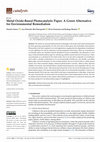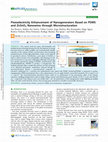Papers by Rita Branquinho

Solution-based synthesis of metal oxides has been attracting a lot of attention due to the low-co... more Solution-based synthesis of metal oxides has been attracting a lot of attention due to the low-cost, high-throughput, and efficient control over chemical composition. These materials also have outstanding properties such as high optical transparency, chemical and thermal stability, and mechanical toughness. In addition, facile tailoring of physical and chemical attributes of these materials leads to multifunctionality that allows their applications in different areas, like sensing, energy, and flexible displays. Particularly for large-area electronics, the exploration of crucial components, the thin film transistor (TFT) and their key material constituents, e.g., the semiconductor, the dielectric, the conductor as well as substrates opens up enormous opportunity to bring forth next generation devices. This chapter focuses on recent low-temperature approaches, such as combustion synthesis and (UV, NIR) irradiation treatments which allow realization of printable flexible TFTs. Moreove...

Since Ion Sensitive Field Effect Transistors (ISFETs) were introduced by Bergveld in 1970, much e... more Since Ion Sensitive Field Effect Transistors (ISFETs) were introduced by Bergveld in 1970, much effort is put into new and improved materials for device optimization and sensitivity enhancement. ISFET based biosensors have a fast response, are suitable for miniaturization and arrays can be made for simultaneous measurement of various parameters. Actually, ISFET device production relies on standard CMOS technology where miniaturization and chip integration is easily achieved but high processing temperatures are required. Amorphous semiconductor oxides, such GIZO (compound mixture of Ga2O3:In2O3:ZnO), are considered as a promising material as an alternative to silicon due to is high mobility, and TFTs based on this ternary system have already proven to have high electronic performances. An advantageous technique for these oxide films deposition is radiofrequency (rf) magnetron sputtering because it permits the production at low temperatures of good quality films with smooth surfaces a...

Nanomaterials
Solution-processed metal oxides have been investigated as an alternative to vacuum-based oxides t... more Solution-processed metal oxides have been investigated as an alternative to vacuum-based oxides to implement low-cost, high-performance electronic devices on flexible transparent substrates. However, their electrical properties need to be enhanced to apply at industrial scale. Amorphous indium-gallium-zinc oxide (a-IGZO) is the most-used transparent semiconductor metal oxide as an active channel layer in thin-film transistors (TFTs), due to its superior electrical properties. The present work evaluates the influence of composition, thickness and ageing on the electrical properties of solution a-IGZO TFTs, using solution combustion synthesis method, with urea as fuel. After optimizing the semiconductor properties, low-voltage TFTs were obtained by implementing a back-surface passivated 3-layer In:Ga:Zn 3:1:1 with a solution-processed high-к dielectric; AlOx. The devices show saturation mobility of 3.2 cm2 V−1 s−1, IOn/IOff of 106, SS of 73 mV dec−1 and VOn of 0.18 V, thus demonstrati...
Journal of Materials Chemistry C
Printed combustion-based aluminium oxide (AlOx) resistive switching devices produced at low tempe... more Printed combustion-based aluminium oxide (AlOx) resistive switching devices produced at low temperature show a high reproducibility (95%) and multilevel cell operation with potential for hardware security applications.

Catalysts
The interest in advanced photocatalytic technologies with metal oxide-based nanomaterials has bee... more The interest in advanced photocatalytic technologies with metal oxide-based nanomaterials has been growing exponentially over the years due to their green and sustainable characteristics. Photocatalysis has been employed in several applications ranging from the degradation of pollutants to water splitting, CO2 and N2 reductions, and microorganism inactivation. However, to maintain its eco-friendly aspect, new solutions must be identified to ensure sustainability. One alternative is creating an enhanced photocatalytic paper by introducing cellulose-based materials to the process. Paper can participate as a substrate for the metal oxides, but it can also form composites or membranes, and it adds a valuable contribution as it is environmentally friendly, low-cost, flexible, recyclable, lightweight, and earth abundant. In term of photocatalysts, the use of metal oxides is widely spread, mostly since these materials display enhanced photocatalytic activities, allied to their chemical sta...
ACS Applied Nano Materials

Sustainability
Sunlight is arguably the most promising continuous and cheap alternative sustainable energy sourc... more Sunlight is arguably the most promising continuous and cheap alternative sustainable energy source available at almost all living places of the human world. Photovoltaics (PV) is a process of direct conversion of sunlight into electricity and has become a technology of choice for sustainable production of cleaner and safer energy. The solar cell is the main component of any PV technology and transparent conducting oxides (TCO) comprising wide band gap semiconductors are an essential component of every PV technology. In this research, transparent conducting thin films were prepared by solution combustion synthesis of metal oxide nitrates wherein the use of indium is substituted or reduced. Individual 0.5 M indium, gallium and zinc oxide source solutions were mixed in ratios of 1:9 and 9:1 to obtain precursor solutions. Indium-rich IZO (A1), zinc-rich IZO (B1), gallium-rich GZO (C1) and zinc-rich GZO (D1) thin films were prepared through spin coating deposition. In the case of A1 and ...
Proceedings of 2nd International Online-Conference on Nanomaterials
Zinc-tin oxide (ZTO) nanostructures appear as one of the most promising material systems for a ne... more Zinc-tin oxide (ZTO) nanostructures appear as one of the most promising material systems for a new generation of nanodevices. In this work, a microwave-assisted hydrothermal synthesis to produce different shapes of Zn2SnO4 nanostructures (nanoparticles, octahedrons and nanoplates) is presented. Reproducible and homogeneous results were obtained with the advantage of reducing up to 20 h the synthesis time when compared to using a conventional oven. Furthermore, the photocatalytic activity of the Zn2SnO4 nanostructures in the degradation of rhodamine B under UV light was studied. Zn2SnO4 nanoparticles demonstrated better performance with >90% of degradation being achieved in 2.5 h.
Chemistry – A European Journal
Journal of Materials Chemistry C
Excimer laser annealing (ELA) combined with combustion synthesis leads to high quality metal oxid... more Excimer laser annealing (ELA) combined with combustion synthesis leads to high quality metal oxide TFTs in a short processing time.
Chemistry – A European Journal

ACS Applied Materials & Interfaces
The current trend for smart, self-sustainable, and multifunctional technology demands for the dev... more The current trend for smart, self-sustainable, and multifunctional technology demands for the development of energy harvesters based on widely available and environmentally friendly materials. In this context, ZnSnO 3 nanostructures show promising potential because of their high polarization, which can be explored in piezoelectric devices. Nevertheless, a pure phase of ZnSnO 3 is hard to achieve because of its metastability, and obtaining it in the form of nanowires is even more challenging. Although some groups have already reported the mixing of ZnSnO 3 nanostructures with polydimethylsiloxane (PDMS) to produce a nanogenerator, the resultant polymeric film is usually flat and does not take advantage of an enhanced piezoelectric contribution achieved through its microstructuration. Herein, a microstructured composite of nanowires synthesized by a seed-layer free hydrothermal route mixed with PDMS (ZnSnO 3 @PDMS) is proposed to produce nanogenerators. PFM measurements show a clear enhancement of d 33 for single ZnSnO 3 versus ZnO nanowires (23 ± 4 pm/V vs 9 ± 2 pm/V). The microstructuration introduced herein results in an enhancement of the piezoelectric effect of the ZnSnO 3 nanowires, enabling nanogenerators with an output voltage, current, and instantaneous power density of 120 V, 13 μA, and 230 μW• cm −2 , respectively. Even using an active area smaller than 1 cm 2 , the performance of this nanogenerator enables lighting up multiple LEDs and other small electronic devices, thus proving great potential for wearables and portable electronics.
Journal of Materials Chemistry C
A typical schematic for both spray pyrolysis set-up and ZrOx-based TFT device, and the correspond... more A typical schematic for both spray pyrolysis set-up and ZrOx-based TFT device, and the corresponding electrical performance.
Advanced Electronic Materials

Nanomaterials
ZnSnO3 semiconductor nanostructures have several applications as photocatalysis, gas sensors, and... more ZnSnO3 semiconductor nanostructures have several applications as photocatalysis, gas sensors, and energy harvesting. However, due to its multicomponent nature, the synthesis is far more complex than its binary counter parts. The complexity increases even more when aiming for low-cost and low-temperature processes as in hydrothermal methods. Knowing in detail the influence of all the parameters involved in these processes is imperative, in order to properly control the synthesis to achieve the desired final product. Thus, this paper presents a study of the influence of the physical parameters involved in the hydrothermal synthesis of ZnSnO3 nanowires, namely volume, reaction time, and process temperature. Based on this study a growth mechanism for the complex Zn:Sn:O system is proposed. Two zinc precursors, zinc chloride and zinc acetate, were studied, showing that although the growth mechanism is inherent to the material itself, the chemical reactions for different conditions need t...
Semiconductor Science and Technology

Uploads
Papers by Rita Branquinho